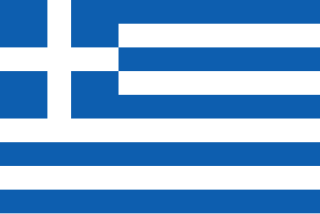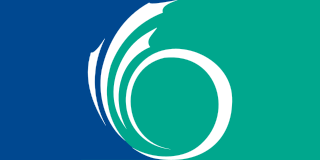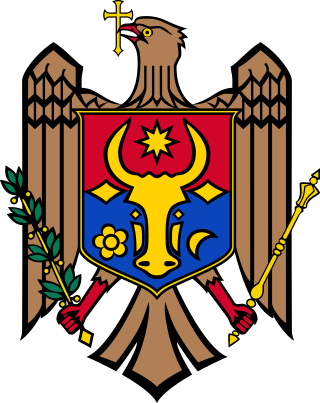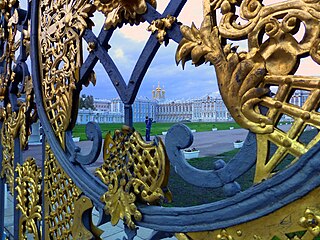Verden is a Kreis (district) in the centre of Lower Saxony, Germany. Adjoining it are the districts of Osterholz, Rotenburg, Heidekreis, Nienburg, and Diepholz, as well as the city of Bremen.

The national flag of Greece, popularly referred to as the Blue-and-White or the Cyan-and-White, is officially recognised by Greece as one of its national symbols and has 5 equal horizontal stripes of blue alternating with white. There is a blue canton in the upper hoist-side corner bearing a white cross; the cross symbolises Eastern Orthodox Christianity. The blazon of the flag is Azure, four bars Argent; on a canton of the field a Greek cross throughout of the second. The official flag ratio is 2:3. The shade of blue used in the flag has varied throughout its history, from light blue to dark blue, the latter being increasingly used since the late 1960s. It was officially adopted by the First National Assembly at Epidaurus on 13 January 1822.

The Port of London Authority (PLA) is a self-funding public trust established on 31 March 1909 in accordance with the Port of London Act 1908 to govern the Port of London. Its responsibility extends over the Tideway of the River Thames and its continuation. It maintains and supervises navigation, and protects the river's environment.

The national flag of the Russian Federation is a tricolour of three equal horizontal bands: white on the top, blue in the middle, and red on the bottom.

Kotka is a town in Finland, located on the southeastern coast of the country at the mouth of the Kymi River. The population of Kotka is approximately 50,000, while the sub-region has a population of approximately 79,000. It is the 21st most populous municipality in Finland, and the 16th most populous urban area in the country.

The coat of arms of Russia derives from the earlier coat of arms of the Russian Empire. Though modified more than once since the reign of Ivan III (1462–1505), the current coat of arms is directly derived from its medieval original, with the double-headed eagle having Byzantine and earlier antecedents. The general tincture corresponds to the fifteenth-century standard.

Novorossiysk is a city in Krasnodar Krai, Russia. It is one of the largest ports on the Black Sea. It is one of the few cities designated by the Soviet Union as a Hero City. The population was 262,293 (2021 Census); 241,952 (2010 Census); 232,079 (2002 Census); 185,938 (1989 Soviet census).

The official flag of Ottawa is highlighted by a stylized white "O" design. This stylized O is meant to represent both a maple leaf and the Peace Tower and Centre Block of the parliament buildings. The design is meant to be simple, but look festive, and to create a feeling of vibrant motion when flying.

Canting arms are heraldic bearings that represent the bearer's name in a visual pun or rebus.

A cross pattée, cross patty or Pate, or cross paty, also known as a cross formy or cross formée or Templar cross, is a type of Christian cross with arms that are narrow at the centre, and often flared in a curve or straight line shape, to be broader at the perimeter. The form appears very early in medieval art, for example in a metalwork treasure binding given to Monza Cathedral by Lombard queen Theodelinda, and the 8th-century lower cover of the Lindau Gospels in the Morgan Library. An early English example from the start of the age of heraldry proper is found in the arms of Baron Berkeley.

The anchored cross, or mariner's cross, is a stylized cross in the shape of an anchor. It is a symbol which is shaped like a plus sign depicted with anchor-like fluke protrusions at its base. There are many variations on this symbol, but the most common form connects a ring with a bar, with a cross-bar, terminating on the other end with two curved branches or arrowheads. The anchor symbolizes hope, steadfastness, calm and composure. It also can symbolize security in one or more uncertain experiences of life, such as sea voyages, one's fate after death, and the vagaries of fortune.

The coat of arms of Moldova is the national emblem of the Republic of Moldova. It was designed by the Moldovan artist Gheorghe Vrabie.

The coat of arms of Montenegro was officially adopted by the law passed in the Parliament on 12 July 2004. It is now the central motif of the flag of Montenegro, as well as the coat of arms of the Armed Forces of Montenegro. It was constitutionally sanctioned by the Constitution proclaimed on 2 October 2007.

Ingersheim is a municipality in the district of Ludwigsburg in Baden-Württemberg in Germany, belonging to the Stuttgart Region.

The fences in Saint Petersburg, Russia are highly varied, with many notable examples remaining in use today from different periods in Russian architectural history.

The flag of Voronezh Oblast, a federal subject of Russia, was adopted 5 July 2005. The flag is a field of red, with a grouping of yellow rocks on the hoist side. Over the rocks, a liquid pours out of a turned-over white vase. It is also on the Voronezhan coat of arms. The ratio of the flag is 2:3.

The flag of Bremen consists of at least eight equal horizontal stripes of red alternating with white, and checked at the hoist. It is colloquially known as Speckflagge. The civil flag does not contain the coat of arms. The state flag exists in three versions

The coat of arms of Saint Petersburg is the official symbol of the city and was adopted in 23 April 2003.

The coat of arms of Sevastopol is a heraldic symbol representing the city of Sevastopol, Crimea. It is featured in the middle of the flag of Sevastopol on a red background.
This is a list article about flags that have been used by pro-Russian separatists in Ukraine and in areas occupied by Russia and Russian-controlled forces during the Russo-Ukrainian War.


















